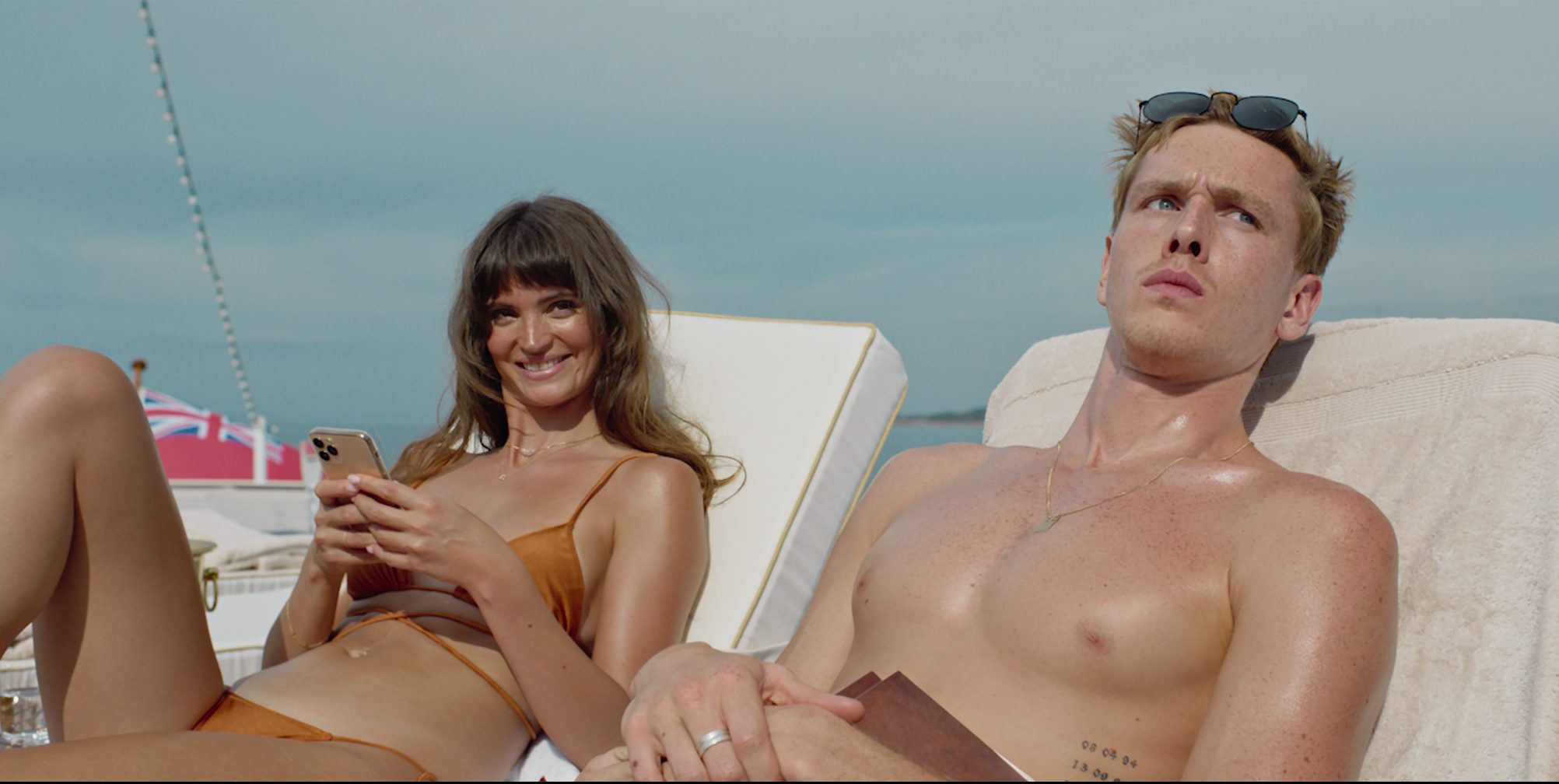
If any film can make you rethink your stance on riotous and gratuitous on-screen barfing, it’s Ruben Östlund’s two-and-a-half-hour epic of a satire Triangle of Sadness. A good chunk of the movie is set on a luxury cruise ship, and somewhere mid-film, most of the characters Östlund has introduced in the first half fall prey to seasickness, spraying semi-digested fine-dining delicacies hither and yon. Even those not particularly disposed to displays of extended projectile vomiting will have to admit Östlund’s skill in this arena: He pushes the gross-out gag so far that it becomes a lawless symphony. You won’t see a better, more elegantly sustained upchucking sequence all year.
But is it wrong to want more?
Triangle—which Östlund wrote and directed, and which won the Palme d’Or at Cannes last spring—is a comedy of manners about people who have none. In the early scenes we meet a few of them: The talented and ultra-handsome actor Harris Dickinson (he’s played both an anguished working-class Brooklyn teenager in Beach Rats and a live-action prince in Maleficent: Mistress of Evil) is Carl, a male model who’s shown up for a casting call. In the opening gag, a roaming interviewer quizzes the guys who are waiting to be seen and judged, asking them to display appropriate expressions for “smiley brands,” like H&M, as opposed to “grumpy brands,” a la Balenciaga. A group of them, shirtless and stunning, oblige. A little later, one model appears before the unsmiling casting tribunal, awaiting their instructions as a Boston terrier lingers for no good reason in the background. This is the sort of roguish, pointed nonsense Östlund is great at. In a slightly later scene, we see Carl and his girlfriend Yaya (Charlbi Dean), also a model, finishing dinner in a fancy restaurant. The check comes, and without looking up from her phone, Yaya purrs, “Thank you, honey, that’s so sweet of you.” Carl bristles, and the conversation that follows goes so far beyond the basic question of “Why is the man always expected to pay?” that you start to wonder if it’s a good idea for men and women to ever get together in the first place.
It’s all so promising, and the fact that Östlund allows these early scenes to ramble a bit is a testament to his outsized confidence: their shapelessness is its own shape, sharp as an elbow. You wonder where he’s going, and you’re happy to follow along. It doesn’t hurt that the film is beautifully crafted. Even if you stop laughing at it, Östlund’s supreme control over individual scenes and his willingness to let his actors stretch out remain exemplary.
Read More: The 52 Most Anticipated Movies of Fall 2022
Yet it’s possible to admire Triangle of Sadness without liking it very much. Östlund is the director of the smart and sly avalanche comedy Force Majeure, as well as the caustic art-world sendup The Square. He’s a smartie for sure. But past a certain point, a director showing off his chops becomes just a lot of chomping. Triangle unfolds in three parts: The first, shortest and best, introduces Carl and Yaya, who’s not just a model but also one of those tiresome creatures known as an “influencer,” though Dean gives her some additional, unexpected shading. (Dean died suddenly in August, a sad footnote to the film’s post-Cannes trajectory.) The film’s second chapter takes place on the cruise ship, where, as a perk of Yaya’s influencing, Carl and Yaya are passengers. Others include a cheerful, self-proclaimed fertilizer king from Russia (Zlatko Buric), who has brought along not just his wife (Sunnyi Melles) but also his mistress (Carolina Gynning); a sweet elderly couple (Amanda Walker and Oliver Ford Davies) who have made a fortune in the manufacture of hand grenades; and a stroke victim in a wheelchair (Iris Berben), who has only one phrase at her disposal, one she uses repeatedly to great effect.
The ship’s captain is played by Woody Harrelson; he’s a reclusive oddball who’s well versed in Marxist philosophy, and he and the avowed Capitalist fertilizer king engage in an extended, drunken, good-natured duel. (This is what’s happening while everyone else is vomiting.) The novelty of their sparring wears off quickly, though Östlund uses it as a preamble for a cleverly orchestrated bit of madness, an elaborate tableau of above-and-below-deck chaos—it all sort of works. Keep an eye out for Abigail, the ship’s “toilet manager” (Dolly De Leon, in the film’s best performance); she’ll play a crucial role in the film’s third section, set on a remote island, the specifics of which shouldn’t be spoiled. If you make it that far, you at least deserve to be surprised.
Because there’s a point where all this belabored skewering starts to lose effect. You can fully agree that most “haves” are dreadful, and that the “have nots” deserve much more out of life, and still be exhausted and bored by Triangle of Sadness and its quirky acidity. The whole enterprise is gorgeous to look at: cinematographer Frederik Wenzel shows how the sun is an expensive blessing on a cruise ship and a searing curse when you’re stuck on an island. Triangle of Sadness definitely looks like money. But it feels like a luxury item, a picture whose payoff isn’t as grand as you might have hoped. Östlund’s gifts are dazzling. If only he knew when to stop giving.
More Must-Reads from TIME
- Cybersecurity Experts Are Sounding the Alarm on DOGE
- Meet the 2025 Women of the Year
- The Harsh Truth About Disability Inclusion
- Why Do More Young Adults Have Cancer?
- Colman Domingo Leads With Radical Love
- How to Get Better at Doing Things Alone
- Michelle Zauner Stares Down the Darkness
Contact us at letters@time.com